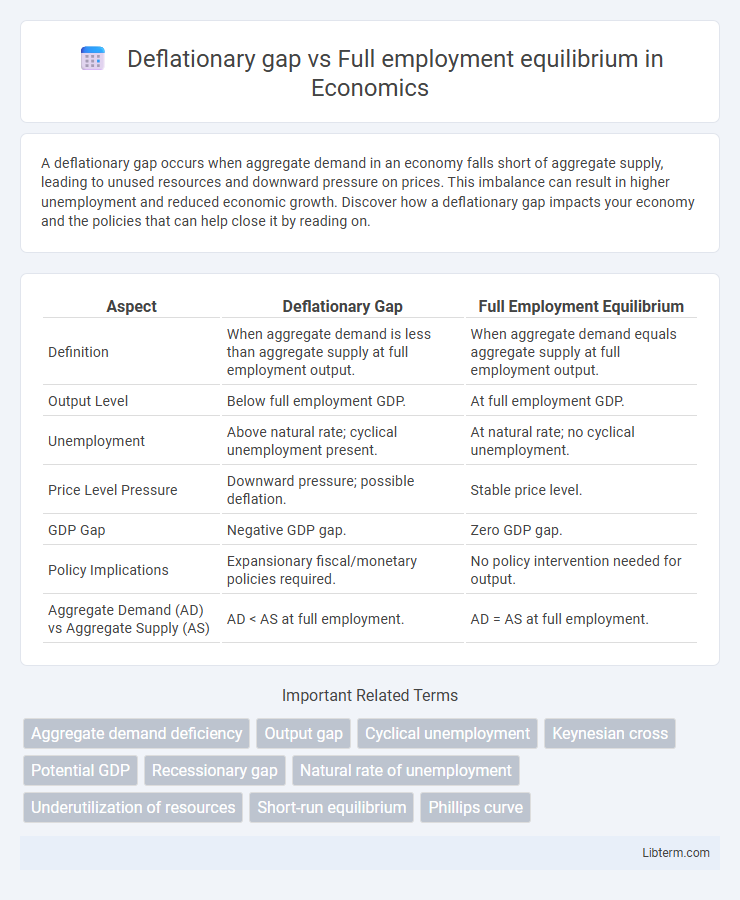A deflationary gap occurs when aggregate demand in an economy falls short of aggregate supply, leading to unused resources and downward pressure on prices. This imbalance can result in higher unemployment and reduced economic growth. Discover how a deflationary gap impacts your economy and the policies that can help close it by reading on.
Table of Comparison
| Aspect | Deflationary Gap | Full Employment Equilibrium |
|---|---|---|
| Definition | When aggregate demand is less than aggregate supply at full employment output. | When aggregate demand equals aggregate supply at full employment output. |
| Output Level | Below full employment GDP. | At full employment GDP. |
| Unemployment | Above natural rate; cyclical unemployment present. | At natural rate; no cyclical unemployment. |
| Price Level Pressure | Downward pressure; possible deflation. | Stable price level. |
| GDP Gap | Negative GDP gap. | Zero GDP gap. |
| Policy Implications | Expansionary fiscal/monetary policies required. | No policy intervention needed for output. |
| Aggregate Demand (AD) vs Aggregate Supply (AS) | AD < AS at full employment. | AD = AS at full employment. |
Understanding Deflationary Gap
A deflationary gap occurs when aggregate demand in an economy is insufficient to purchase the full employment level of output, resulting in unemployment and unused productive capacity. In this situation, actual GDP falls below potential GDP, causing downward pressure on prices and wages, leading to reduced economic activity. Understanding the deflationary gap highlights the need for fiscal or monetary policies to stimulate demand and move the economy toward full employment equilibrium, where aggregate demand matches potential output and resources are fully utilized.
Defining Full Employment Equilibrium
Full employment equilibrium occurs when an economy's aggregate demand equals its aggregate supply at a level of output where all available labor resources are utilized efficiently without causing inflation. In this state, the unemployment rate corresponds to the natural rate of unemployment, reflecting frictional and structural unemployment rather than cyclical. A deflationary gap, by contrast, arises when aggregate demand falls short of aggregate supply, leading to underemployment and downward pressure on prices.
Key Differences Between Deflationary Gap and Full Employment
A deflationary gap occurs when aggregate demand is insufficient to purchase the full output produced at full employment, resulting in unemployment and idle resources. Full employment equilibrium is achieved when aggregate demand matches the economy's potential output, maximizing resource utilization without inflationary pressure. The key difference lies in the output level relative to full employment: deflationary gaps indicate underproduction and underutilization, while full employment equilibrium signifies optimal production with stable prices.
Causes of a Deflationary Gap
A deflationary gap occurs when aggregate demand in the economy falls short of the full employment level of output, leading to unused resources and unemployment. Causes include a decrease in consumer spending, reduced investment by businesses, government budget cuts, or a decline in net exports. This gap indicates insufficient demand to employ all available labor and capital, in contrast to the full employment equilibrium where supply matches demand, and the economy operates at its potential output.
Economic Impacts of Deflationary Gaps
A deflationary gap occurs when aggregate demand falls short of an economy's full employment output, leading to underutilized resources and rising unemployment. This gap causes downward pressure on prices and wages, reducing business revenues and consumer spending, which can further slow economic growth. Persistent deflationary gaps risk triggering a cycle of declining demand and output, increasing the severity of recessions and hindering long-term economic stability.
Indicators of Full Employment Equilibrium
Full Employment Equilibrium is indicated when the actual output of an economy matches its potential output at the natural rate of unemployment, signaling that all available resources are efficiently utilized. Key indicators include low and stable unemployment rates close to the natural rate, consistent inflation within target ranges, and balanced aggregate demand and aggregate supply without upward or downward pressure on prices. In contrast, a deflationary gap occurs when actual output falls below potential output, leading to unemployment rates above the natural level and downward pressure on prices.
Aggregate Demand and Aggregate Supply Analysis
A deflationary gap occurs when aggregate demand (AD) is insufficient to purchase the full employment level of output, resulting in unemployment and downward pressure on prices. In contrast, full employment equilibrium is achieved when aggregate demand equals aggregate supply (AS) at the economy's potential output, stabilizing prices and ensuring optimal utilization of resources. The gap highlights a shortfall in AD relative to AS, whereas full employment equilibrium reflects balanced AD and AS at maximum productive efficiency.
Policy Measures to Address Deflationary Gaps
Deflationary gaps occur when aggregate demand falls short of the economy's productive capacity, leading to unemployment and downward pressure on prices. Policy measures to address deflationary gaps include expansionary fiscal policies such as increased government spending and tax cuts, alongside accommodative monetary policies like lowering interest rates and quantitative easing to stimulate demand. These interventions aim to shift aggregate demand toward full employment equilibrium, where all available labor resources are utilized and inflation remains stable.
Case Studies: Historical Examples
The deflationary gap occurs when aggregate demand is insufficient to achieve full employment equilibrium, leading to unemployment and underutilized resources. Historical examples include the Great Depression of the 1930s, where demand contraction caused prolonged unemployment and output below potential GDP. In contrast, the post-World War II U.S. economy during the 1950s demonstrated full employment equilibrium, characterized by stable inflation and maximum sustainable output levels.
Deflationary Gap vs Full Employment: Implications for Economic Growth
A deflationary gap occurs when aggregate demand falls short of the economy's full employment output, leading to unused resources and unemployment, whereas full employment equilibrium means the economy is producing at its potential output with stable inflation. Persistent deflationary gaps hinder economic growth by causing reduced consumer spending, lower business investment, and increased unemployment, which suppresses overall demand. In contrast, full employment equilibrium fosters sustainable economic growth through optimal resource utilization, higher consumer confidence, and balanced inflation rates.
Deflationary gap Infographic

 libterm.com
libterm.com